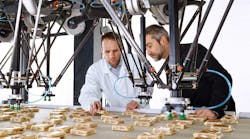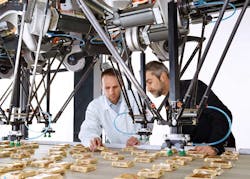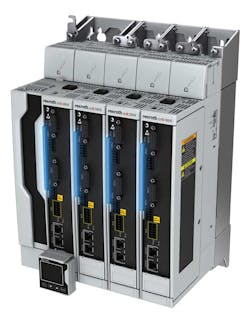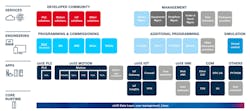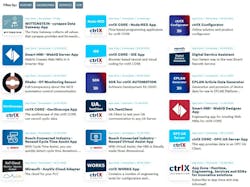At A Glance:
- The goal is to allow the PLC to be continually upgraded like a smartphone instead of being doomed to obsolescence.
- Controller manufacturers have created their own app stores to provide links for design and operational software to customers.
- A new generation of machine controllers allows designers to leverage open architecture tools to drive manufacturing innovation.
The PLC—the programmable logic controller, or automation controller—has been the central tool used to drive advances in automation efficiency, productivity and flexibility for several decades. Automation machine controllers have evolved through several generations of hardware and software, taking advantage of advances in processor power, sophistication and high-speed, Ethernet-based automation protocols to drive increases in automation throughput and productivity.
Until recently, machine controller architectures—both hardware and software—evolved somewhat in isolation from the broader computing and IT platforms that have transformed the globe. However, a new generation of modern machine controllers is revolutionizing the industry, providing technology that offers a whole new kind of openness and ease of use, while still supporting the complex functionality that current and future automation systems demand.
“Old vs. New”: Limitations of Prior Controller Platforms
Prior generations of machine controllers made effective use of advances in processor technology and communication interfaces to provide support for even faster automation control requirements. They also provided other functionality, such as increased use of sensors and vision systems. However, a significant limitation of these systems was the way that controller technology developed in isolation from broader trends in the world of IT.
The broader IT world has an open software architecture, unlike many controller platforms. Today’s smartphones provide the perfect model. Smartphone operating systems provide the foundation for an unending array of specialized programs and apps that are easily downloaded and intuitive to use. This openness and interoperability have enabled constant creativity for outside developers to enhance smartphone functionality.
In contrast, controller technology has continued to be much more closed, thereby limiting the ability of automation OEMs to have long-term flexibility and control of their systems. For example: If a packaging systems OEM wants to develop a new generation of machines, it is typically forced to make an early judgment in the design process about which controller family to use.
From that point on, that family of machines is wedded to that controller platform and the how the supplier supports the controller over time. Because of these architecture constraints, it could be very difficult to switch to a different platform or alternative controller: Each controller uses a different operating system or proprietary software, making it more difficult and expensive to offer the same machine with options for a different machine controller.
Because the software architecture of these proprietary controllers has been so tightly controlled, the platform often did not support newly emerging capabilities or applications. Automation OEMs were limited in their ability to support new applications, particularly for functionality sought after in Industry 4.0 manufacturing operations.
If a manufacturer wanted to be able to monitor and collect machine performance data from all its machines plantwide and cleanly link up that data through cloud applications for real-time analysis and long-term systems management, that kind of functionality often had to be specially developed through custom drivers and specialized communications.
However, a new generation of machine controllers is emerging to overcome these limitations and free the automation community to leverage the openness and sophistication of these new tools to drive manufacturing innovation.
Openness: Key Traits of New Machine Controllers
Today’s state-of-the-art machine controllers are rapidly moving away from the closed, proprietary architectures of prior systems. Here are five key traits that machine builders and automation end-users should consider when assessing different platforms.
1. Apps-based architecture. One of the most significant differences between past and current machine controller platforms is how open and app-based the most advanced of them have become. Nowadays, software development accounts for more than half of the value creation in automation engineering. For machine manufacturers and end-customers, efficient engineering and straightforward application programming offer a considerable potential for savings and degree of freedom.
The most obvious model for this approach is the smartphone, with highly stable, robust operating systems incorporating features such as encrypted data layers that enable multiple automation apps to communicate and share information with each other.
In modern machine controllers, the open software architecture with flexible app technology lets OEMs select the apps that they need or use any open-source software. They can use software they developed themselves on the open platform and use their expert automation and controls knowledge to create machine-specific apps in whatever popular programming language fits their needs.
Leading controller manufacturers such as Bosch Rexroth are even creating “app stores” where compatible apps for specialized machine functions, such as vision inspections systems or predictive maintenance tools developed by companies that specialize in that kind of software, can be downloaded for use—a further example of the smartphone model.
2. Hardware. The performance demands placed on this new generation of controllers requires top-notch hardware. There are controller providers who are launching Linux-based multicore processors with the speed and sophistication to support the most demanding requirements.
Multicore processors provide a critical advantage in the app-driven architecture: Controllers are now being asked to handle a much wider range of functions simultaneous to the core automation, I/O and motion sequence control of the machine. No matter how powerful, a single processor handling 64 axes of deterministic motion control as well as supporting data collection and other app functions is likely to bog down.
With a multicore processor, one core can be dedicated just to machine control, while another core supports leading-edge apps like machine learning or database maintenance. The use of Linux as the foundation for the operating system makes sense because it is a proven, open-source platform that has millions of developers updating and enhancing its capabilities.
There are versions of Linux that have been developed to support real-time, high-speed processing in other applications and have demonstrated reliable, robust performance, making it eminently suitable for use in the most demanding automation applications in combination with the multicore processor architecture.
3. Connectivity. The need for open and fast communications capabilities is every bit as important as the advances in software architecture and hardware performance. The automation industry has made great strides toward the use of high-speed, Ethernet-based bus architectures that promise greater openness and interoperability.
The newest controllers are rapidly promoting support for the EtherCAT protocol, which is being adopted as a de facto standard bus in demanding industries such as semiconductor fabrication. EtherCAT also has the advantage of being more motion-centric, a valuable asset for automation applications.
However, it’s important to assess whether a controller line is open to supporting other popular protocols such as Sercos, EtherNet/IP or PROFINET. In addition, there is growing support for emerging protocols such as OPC-UA and Time-Sensitive Networking (TSN); machine controllers equipped with an open architecture to support these options besides EtherCAT can provide a valuable, future-proof solution.
4. Stable and scalable. In the past, controller portfolios would often be restrictive in how scalable they were. To use that platform across the entire machine, automation OEMs were sometimes forced to select controllers with more features and power than a given machine axis or set of axes needed.
Smart scalability is a key advantage of the new generation of open machine controllers, with base platforms that can be scaled up with additional app functionality as needed. Instead of having dozens or hundreds of different controllers with specific functionality determined by hardware, the core architecture lets the automation OEM scale as needed.
Many of the leading-edge controllers provide powerful tools to let the OEM periodically access the controller’s core to provide software updates, patches and revisions—exactly the same way most major business applications and PC programs are supported.
In addition, some controller suppliers offer a wider range of controller options. A single control can be deployed as a standard cabinet-mounted controller as part of an industrial PC or in a distributed, drive-based controller solution. The same control, with the same OS and interfaces, can even make it possible to implement hybrid solutions combining drive-integrated and cabinet-based controller platforms on a single machine, without requiring specialized knowledge or different programming capabilities.
5. The total automation platform. While the industry has plenty of companies that focus almost exclusively on supplying PLCs or motion control drives, there are significant advantages to selecting a machine controller that is part of a larger automation portfolio, all designed and engineered to communicate and work together with the highest degree of efficiency and versatility. Key elements of a complete automation platform, including drives, HMIs, I/O and programming platforms that share common hardware, firmware and software, can significantly simplify and save engineering time and resources.
In these total platforms, system functions seamlessly complement each other and can also be extended by apps and third-party hardware and software thanks to the absolute openness of the system. Superior connectivity is supported with virtually all relevant automation protocols, as well as offering freedom in the choice of development environment and programming language.
The “new” machine controller, responding to the needs of Industry 4.0, will deliver the openness, app-driven ease of use and flexibility that will soon make it possible for automation builders to think of their PLC like a smartphone for automation instead of a component destined for obsolescence.
Allen Tubbs is product manager for Bosch Rexroth Corp.
